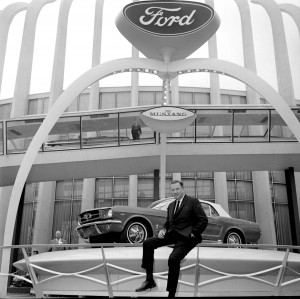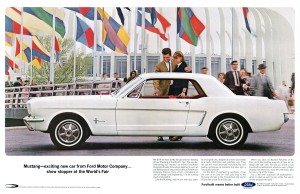
Henry Ford II with the Mustang at the World's Fair in Flushing Meadows, New York, on April 17, 1964.
There’s an old joke about the Mustang that kicks around Ford Motor Company: So many people claim to be the father of the smash hit, you’d hate to be the mother.
Well, Lido Anthony Iacocca or Henry Ford II or whomever, today marks the 45th anniversary of the introduction of the original and still champion pony car at the New York World’s Fair in 1964.
The marketing success of the car hinged on taking a cheap Falcon platform, adding the famous long hood, short rear-deck look to the two-door body and selling it for hundreds upon hundreds of dollars more than the Falcon – the reverse of the incentive plagued environment that Ford finds itself in today.
The car was so good looking that this obvious guise worked, producing enormous profits for Ford and quickly resulting in “me too” copies from Chrysler, General Motors and even economy car maker American Motors, may it rest in peace.
Ford and the Mustang Club of America are commemorating the birth of America’s favorite pony car with a four-day celebration at the Barber Motorsports Park, in Birmingham, Alabama. The party is expected to draw more than 2,500 Mustang enthusiasts and their cars, and Ford hopes hundreds of thousands of spectators. Included among those enthusiasts are nine original owners of a 1964½ Mustang. Before the e-mails arrive, TDB knows that there is no such thing as a 64.5 Mustang. All the cars are 1965 models because they all have a 1965 model year Vehicle Identification Number (VIN) in the I.D. plate.
“People like to say there is no such thing as a 1964½ Mustang, and in theory they are correct,” said Charles Turner, national head judge for the Mustang Club of America (MCA). “But there is a wide range of little differences between the cars built before and after August of 1964 that make them very unique. The MCA accepts the 1964½ as a model year because we view it as a different car.”
The so-called 1964½ Mustangs used generators, while those made during the 12-month 1965 model year used alternators. The V-8 option in 1964½ models used a 260-cubic inch displacement V-8 engine — yes with a carburetor and ignition points and a mechanical distributor. The 1965 models employed a 289 cubic inch V-8 engine.

Those were the days of getting a premium for an economy car instead putting cash on the hood.
When Phil Florio bought his 1964½ Wimbledon White Ford Mustang, he says it was “love at first sight.” Forty-five years later, the love affair is still going strong.
“I’m going to be 71 in May, but when I get behind the wheel of that car and turn the key, I’m 25 years old again,” said Florio, of Summerfield, Fla. “It keeps me young.”
Florio is one of nine original owners of the 1964½ Mustang – America’s first pony car – who will display and share stories at the party.
“I used to drive the car in New York in the middle of winter, and when I got home I’d get blue hands trying to wash the snow and salt off of it in the freezing cold weather,” said Florio. “I loved the car, and knew when I bought it that I was going to keep it for as long as I possibly could,” Florio said.
Well, let the pony car party begin.
